Descripción
Fotos tipos
Morfología
Biología
Bibliografía
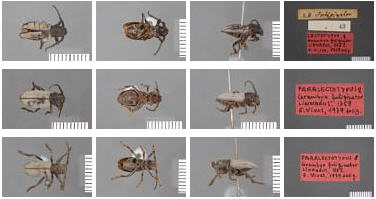
Iberodorcadion fuliginator (Linnaeus, 1758)
Descripción
Fotos tipos
Morfología
Biología
Bibliografía
LINN 8157 Cerambyx fuliginator (Ins Linn)
LINN
8158 Cerambyx fuliginator (Ins Linn)
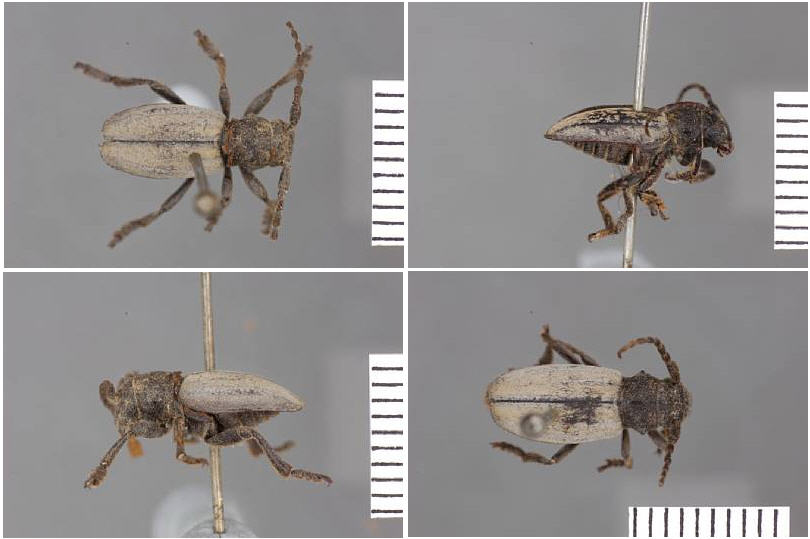
Insects Collection: Cerambyx
fuliginator
Linnean
Collections - The Linnean Society of London
C. Linnaeus (1758) Cerambyx fuliginator Syst. Nat. ed. 10,1:393
Fotografías de D.(I.)
fuliginator en Basilea / Basel (Suiza)
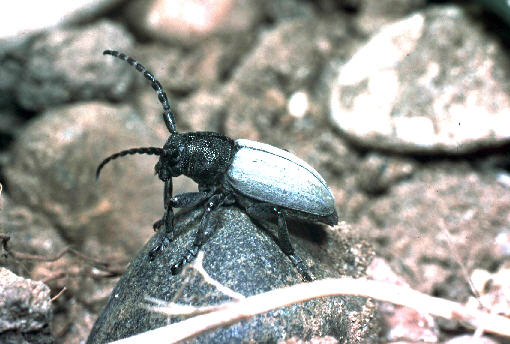
Foto 1 © Armin Coray
Baur B, Burckhardt D, Coray A, Erhardt A, Heinertz R, Ritter M & Zemp M (1997) Der Erdbockkäfer, Dorcadion fuliginator (L., 1758) (Coleoptera: Cerambycidae), in Basel, Mitteilungen der Entomologischen Gesellschaft Basel 47: 59-124
AbstractIn urban areas a variety of plant and animal species and habitat types are threatened or have disappeared. The beetle Dorcardion fuliginator only occurs at two localities in Switzerland, one of them situated on the embankment of the river Rhine (Rheinbord St. Johann) in the centre of Basle. This paper summarizes the present knowledge on the taxonomy, biology and distribution of D. fuliginator, provides evidence for the local extinction of populations of this beetle in the environs of Basle and describes changes in population size and habitat characteristics at the Rheinbord St. Johann.
D. fuliginator has a life cycle of two years. Females deposit their eggs in stems of grasses (preferably Bromus erectus) late in March and April. The larvae hatch in May and pupate after 13.5-14.5 months (including one hibernation in a late larval stage). Adults emerge from the pupae after 2-3 weeks in July or August, but rest in the soil until the end of the second hibernation. Depending on the weather conditions adults emerge from the soil in March or early April and are sexually active for 3-4 weeks.
In the Basle region several local populations of D. fuliginator have become extinct over the past few decades, most probably due to habitat alterations and habitat destruction. At the Rheinbord St. Johann, the area potentially suitable for D. fuliginator has decreased from 1.3 to 2.6 ha at the beginning of the century to 0.45 ha in the years 1967-1984. Since 1990, only 0.28 ha of suitable habitat has been available to the beetles. Over the same period the composition and abundance of plant species have changed at the Rheinbord St. Johann.
The size of the D. fuliginator population has been recorded at the Rheinbord St. Johann since 1986. Due to the two-year life cycle there are two distinct, temporally isolated populations at the same locality: population A with adults in even years and population B with adults in odd years. Using a markrelease-recapture technique the size of the population A was estimated at 800 individuals in 1988. However, since then the size of both populations has decreased; current estimates are 200-400 individuals for population A in 1996 and 100-150 individuals for population B in 1997.
The present article indicates huge gaps in the knowledge on the taxonomy and biology of D. fuliginator and its habitat requirements. There is an urgent need for a special management concept for the highly endangered D. fuliginator population in Basle.

Foto 2 © Richard Heimertz
Baur B., Zschokke S, Coray A, Schläpfer M & Erhardt A (2002) Habitat characteristics of the endangered flightless beetle Dorcadion fuliginator (Coleoptera: Cerambycidae): implications for conservation, Biological Conservation 105: 133-142. Disponible en Internet: http://dx.doi.org/10.1016/S0006-3207(01)00117-3
AbstractHabitat destruction and degradation are the major causes for the decline of the endangered grass-feeding flightless beetle Dorcadion fuliginator in Central Europe. We examined habitat characteristics at 19 localities which still support abundant D. fuliginator populations in the southern part of the Upper Rhine valley (border region of Switzerland, Germany and France) to obtain basic information for the management of deteriorating habitats with declining beetle populations. Populations of D. fuliginator were found in different types of grassland on south, south-west and south-east facing slopes and flat ground. Correspondence analysis showed that plant communities of D. fuliginator localities overlap widely with fertilized, dry hay meadows (phyto-sociologically defined as dry type of the Arrhenatheretum community) and to a minor extent with traditionally extensively cultivated dry grasslands (Xerobrometum and Teucrio-Mesobrometum communities). Average indicator scores of the plant communities characterize the habitat of D. fuliginator as fairly light-exposed and warm, but with relatively large ranges in humidity and nutrient content. The results of a 16-year study on the timing of emergence of the first beetles in a population provided further evidence for the high temperature requirements of D. fuliginator. Proposed conservation measures include traditional cultivation of the present secondary, man-made D. fuliginator habitats, introduction of beetles to suitable motorway embankments as well as large-scale measures allowing natural dynamics in the flood plain along the river Rhine, the presumably primordial habitat of this highly endangered beetle.
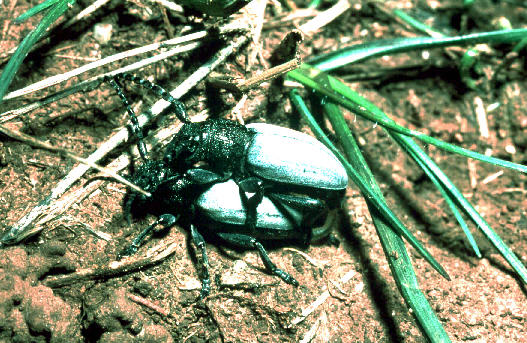
Foto 3 © Richard Heimertz
Baur B, Coray A, Minoretti N & Zschokke S (2005) Dispersal of the endangered flightless beetle Dorcadion fuliginator (Coleoptera: Cerambycidae) in spatially realistic landscapes -- Biological Conservation:49 -61. Disponible en Internet: http://dx.doi.org/10.1016/j.biocon.2004.12.011
AbstractHabitat destruction and degradation are the major causes for the decline of the endangered grass-feeding beetle Dorcadion fuliginator in Central Europe. In the southern part of the Upper Rhine valley (border region of Switzerland, Germany and France) the habitat suitable for this flightless beetle has been reduced to small remnants of extensively managed dry grassland, usually surrounded by intensively cultivated agricultural fields or settlements. Using a mark–release–resight technique we examined movement patterns in three D. fuliginator populations to obtain basic information on the dispersal ability and longevity of this beetle. Estimated daily survival rates ranged from 88.8% to 90.8% in the populations examined. This corresponds to a mean life span of 10.5 days. Distances moved by D. fuliginator differed among populations. The beetles walked the largest distances in the verges of a field track. Several beetles moved distances of 20–100 m along the track, with a maximum distance of 218 m (a male in 12 days). The shortest displacements were recorded in the bank of the river Rhine, a narrow habitat surrounded by tarmac roads. We also assessed the spatial arrangement of 12 patches with D. fuliginator populations in two regions and estimated the size of each population over 4 years. Data on dispersal, daily survival, population size and spatial arrangement of patches were used to simulate patch-specific migration rates. The simulations suggested that in both areas the beetles regularly moved between neighbouring patches separated by distances shorter than 100 m, whereas patches separated by distances exceeding 500 m are isolated.
Detalle cabeza
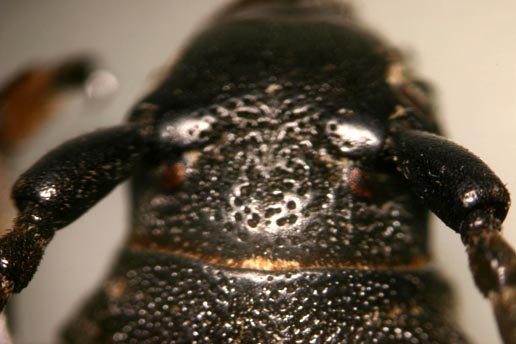
|
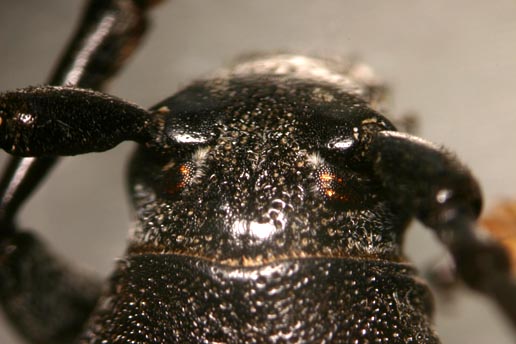
|
Detalle protórax
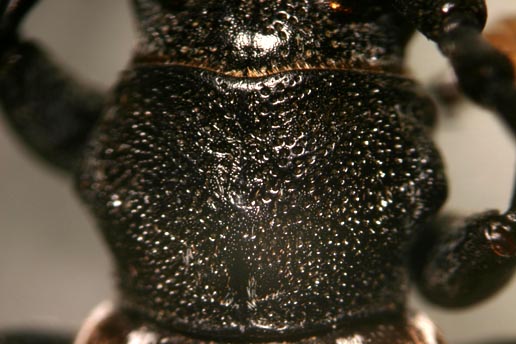
|
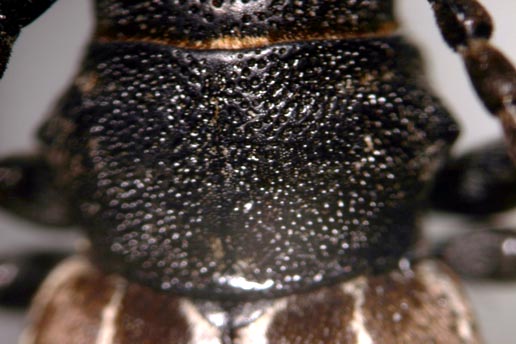
|
Detalle escudete

|
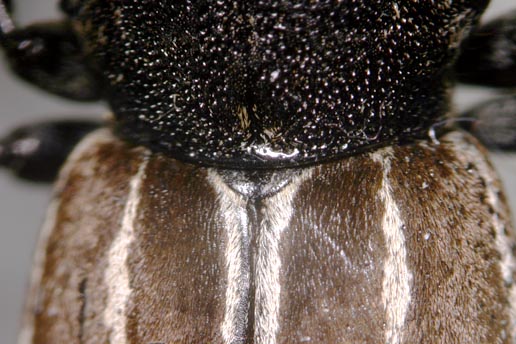
|
Fotografías © José Luis Albalá
FOTOGRAFÍAS I. fuliginator
D.
fuliginator - Blog Dorcadion
D.fuliginator
- Teverener Heide
M.Hoskovec & M. Rejzek
http://www.uochb.cas.cz/~natur/cerambyx/dorfulig.htm
Fotogalerie
Coleoptera (F.Koebler)
http://www.koleopterologie.de/gallery/fhl09/dorcadion-fuliginator-foto-hamers.html
http://www.koleopterologie.de/gallery/fhl09/dorcadion-fuliginator2-foto-hamers.html
http://www.koleopterologie.de/gallery/fhl09/dorcadion-fuliginator-foto-rodenkirchen.html
http://www.koleopterologie.de/gallery/fhl09/dorcadion-fuliginator-foto-bense.html
Sobre
I. fuliginator ssp. andianum
Sobre
los límites entre D.(I.) fuliginator (Linneo,
1758)
y
D.(I.)
circumcinctum (Chevrolat, 1862)
Referencias bibliográficas
Bahillo, P. (1997) Estudio de la variabilidad en las poblaciones de Iberodorcadion fuliginator (Linneo, 1758) del Pais Vasco y Navarra (Coleoptera: Cerambycidae) Vol.Asoc. esp. Ento., 21 (3-4) pp. 211-220.
http://www.entomologica.es/cont/publis/boletines/653.pdfBahillo, P. y Iturrondobetia, J.C. (1996) Cerambícidos (Coleoptera Cerambycidae) del País Vasco, CUAD. INVEST. BIOL., Bilbao, Vol. 19, 244 páginas.
Baur B, Burckhardt D, Coray A, Erhardt A, Heinertz R, Ritter M & Zemp M (1997) Der Erdbockkäfer, Dorcadion fuliginator (L., 1758) (Coleoptera: Cerambycidae), in Basel, Mitteilungen der Entomologischen Gesellschaft Basel 47: 59-124
Baur B, Zschokke S, Coray A, Schläpfer M & Erhardt A (2002) Habitat characteristics of the endangered flightless beetle Dorcadion fuliginator (Coleoptera: Cerambycidae): implications for conservation, Biological Conservation 105: 133-142. http://dx.doi.org/10.1016/S0006-3207(01)00117-3
Baur B, Coray A, Minoretti N & Zschokke S (2005) Dispersal of the endangered flightless beetle Dorcadion fuliginator (Coleoptera: Cerambycidae) in spatially realistic landscapes -- Biological Conservation:49 -61. Consultado en mayo 2005: http://dx.doi.org/10.1016/j.biocon.2004.12.011
Breuning, S. (1957) Les Dorcadion français. L'Entomologiste., 13(2-3):42-55.
Linnaeus, C. (1758) Systema naturae per regna tria naturae, secundum classes, ordines, genera, species, cum characteribus, differentiis, synonymis, locis. Editio decima, reformata. Holmiae. (Laurentii Salvii).Tomus I - [1-4], 1-824 [on line]
Romero, J. (2002), Iconografía del género Iberodorcadion, Argania Editio, Barcelona, 197 pp.
Schaefer, L. (1967) Contribution a l'étude des Dorcadion français (Col. Cerambycidae). Bull. Soc. Linn. Lyon. 36:57-69.
Copyright © Proyecto Iberodorcadion
Comunidad Virtual de Entomología
http://entomologia.rediris.es/